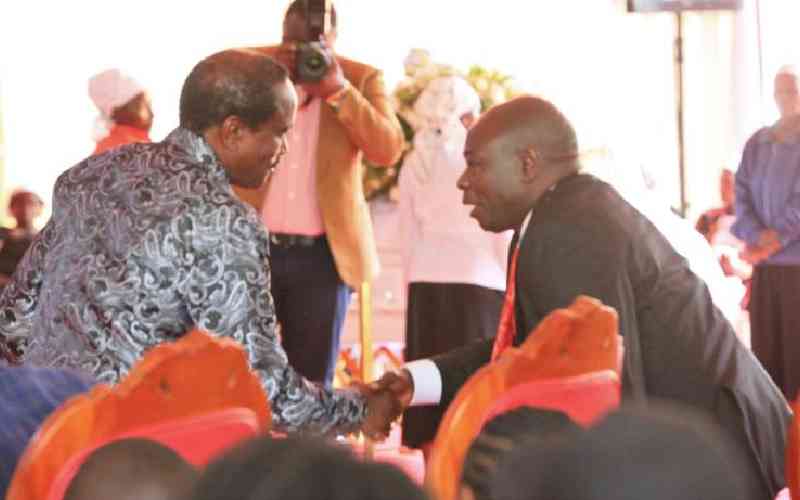By Lillian Aluanga
Christmas sales, carols, concerts, lights and colourful decorations in window displays are among the earliest signs that the season of cheer is at hand.
At the entrance to a clothing store in downtown Nairobi, a shop assistant persistently rings a bell to lure customers into the store.
Until about three months ago, the shop — located along Kenyatta Avenue — sold furniture. That was before making the ‘big switch’ to clothes in the hope of making better sales over the Christmas season.
"The countdown to Christmas has already started. It began as soon as schools closed for the third term break at the end of November," says a supervisor at the store.
Easter is preceded by 40 days of Lent. An equal number of days during the Islamic holy month of Ramadhan precede Idd festivities, while several events culminate in the five-day Hindu celebration of Diwali or Festival of Lights.
But just when does the Christmas season really begin?
"I would say it starts from December 1, through to New Year’s Day. But the fact is the religious meaning attached to the day has considerably diminished with time," says Prof Douglas Waruta of the University of Nairobi.
It is this diminished religious significance attached to Christmas, he says, that makes it difficult for many, particularly those with little knowledge of liturgical observances, to tell exactly when the season begins.
The Ramadhan period includes fasting from dawn to dusk for 40 days as well as abstaining from alcohol and sex. Lent, which is viewed as a season of prayer, self-denial and penitence among Christians, is observed 40 days prior to Easter, which marks the remembrance of Jesus Christ’s’ death and resurrection.
But the same, says Waruta, cannot be said of Christmas, given the commercialism that has increasingly taken over the day.
"For businessmen, the season begins anytime at the start of December because they want to make as much as they can before the actual day," says Waruta, Head of the Philosophy and Religious Studies Department.
For newspaper vendor Kamau Macharia, there is no ‘pre-Christmas’ or Advent season. Christmas simply begins and ends on December 25.
Village Dances
But Macharia, 58, remembers a different pre-Christmas season while growing up in central Kenya. Besides village dances, groups of young boys would move around homes singing hymns and receiving gifts of eggs or maize from the villagers.
Stay informed. Subscribe to our newsletter
"We referred to them as Akorino. When you saw them moving around the village, you knew the Christmas season was on," says Macharia. Festivities would then climax on December 25, when delicacies like chapati were served in homes ‘lucky’ to have relatives visiting from big towns like Nairobi.
"Even the neighbours came to eat chapati in your home because wheat flour was expensive," says Macharia.
At the All Saints Cathedral, Nairobi, Reverend Samson Gachathi gives another dimension to the start of the Christmas season. "One of the symbols that mark the start of the season is the colour of vestment worn by the priests," says Gachathi, a youth pastor at the church.
The season of Advent in the church usually lasts anywhere between 22 to 28 days, but varies from one calendar year to the next.
"This year it began on November 29, but the date could be different next year," says Gachathi.
Besides the teachings and readings at this time being tilted towards the preparation for the Second Coming of Christ, and celebration of Christ’s first coming at Christmas, the colour of vestment also tells a story.
Through Advent, which begins four Sundays before Christmas, up to Christmas Eve, purple-the royal colour of the coming King- is worn. From Christmas day through to commemoration of the baptism of Christ in January, prelates wear white or gold. While green vestments precede the Advent, red is preserved for the Day of Pentecost and Palm Sunday.
Vestment colours to mark various seasons in the church, however vary in different parts of the world. History credits Perpetus, bishop of Tours in 490, as the first church official to propose special activities for the pre-Christmas period. As part of preparations for the holiday, the prelate proposed fasting three days a week from November 11 to December 24. With time, the practice spread to other parts of Europe like Spain, Germany, France and ancient Rome.
"Much of Europe is still very traditional and held on to symbols that gave them an identity even after converting to Christianity," says Waruta.
Often, the symbols were built around stories, which included those told about Christmas. Some stories were later ‘Christianised’ and used to justify the start of the Christmas season
In parts of France, Germany and some Middle East countries like Syria and Lebanon, St Barbara’s Day is marked every December 4, signalling the start of the holiday season.
The day is built around the story of a young girl locked in a tower by her father and killed because of her Christian faith. Her killer was then struck by lightning.
But over time, some historians have doubted the authenticity of the story.
St Lucy’s Day
In Sweden, St Lucy’s Day on December 13 marks the start of the Christmas season. Its annual remembrance in some parts of the world is marked by a girl in every home, garlanded by a wreath of leaves and lit candles on her head. The girl is also expected to make an early breakfast for her family.
Among the Orthodox Christians, the start of Advent is marked by a period of fasting between November 15 and December 24. While much of eastern Europe and parts of the Middle East fasted as part of preparations for the Christmas season, Christians in Rome indulged in feasting. This, however, changed sometime around the 11th century when no feasts, recreational travel, weddings or even marital relations were allowed in the run up to the Advent season.
"The Christmas season gives people a chance to celebrate. Renewal, restoration and celebration rituals will always be important in any society, with or without religion. It was a way of bringing people together, which in a sense is what the Christmas holiday season does," says Waruta.
-Additional information from Christianity Today
 The Standard Group Plc is a
multi-media organization with investments in media platforms spanning newspaper
print operations, television, radio broadcasting, digital and online services. The
Standard Group is recognized as a leading multi-media house in Kenya with a key
influence in matters of national and international interest.
The Standard Group Plc is a
multi-media organization with investments in media platforms spanning newspaper
print operations, television, radio broadcasting, digital and online services. The
Standard Group is recognized as a leading multi-media house in Kenya with a key
influence in matters of national and international interest.
 The Standard Group Plc is a
multi-media organization with investments in media platforms spanning newspaper
print operations, television, radio broadcasting, digital and online services. The
Standard Group is recognized as a leading multi-media house in Kenya with a key
influence in matters of national and international interest.
The Standard Group Plc is a
multi-media organization with investments in media platforms spanning newspaper
print operations, television, radio broadcasting, digital and online services. The
Standard Group is recognized as a leading multi-media house in Kenya with a key
influence in matters of national and international interest.







